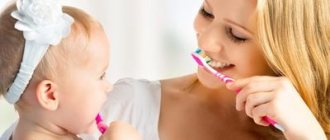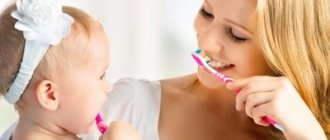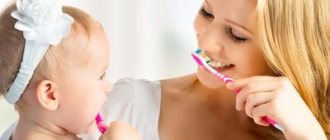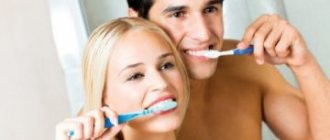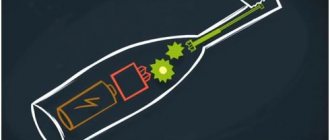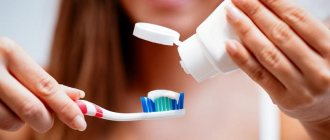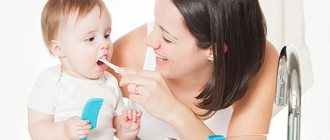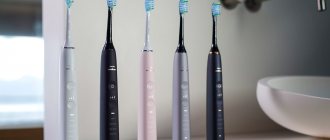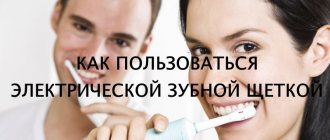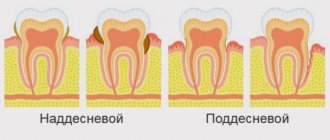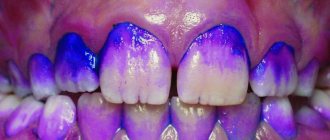Not all parents know how to properly brush their children’s teeth, but the condition of the erupted permanent teeth depends on the quality of care for baby teeth.
. To protect your child from problems with molars, incisors and canines, it is necessary to teach him to brush and rinse his mouth after the very first tooth erupts.
Features of the structure of milk teeth
Baby teeth form in the sixth week of fetal development. Normally there are 20 of them:
- 8 molars;
- 8 incisors;
- 4 fangs.
Temporary teeth consist of the same tissues as permanent teeth:
- dentin (in temporary teeth it is softer and less mineralized);
- enamels;
- pulp.
However, primary incisors, canines and molars have features:
- low crowns;
- large distance between crowns;
- long thin roots that dissolve before the temporary tooth falls out and the permanent tooth erupts;
- thin enamel - only 1 mm;
- wide channels.
The structure of baby teeth is only slightly different from permanent teeth, so they no less need proper care. You can start brushing your child’s teeth after the very first incisor has erupted.
. Early training in hygiene will be an excellent prevention against many dental diseases that can affect the primary incisors, and then the rudiments of the permanent ones formed under them.
If you don’t care for your baby’s teeth or care for them incorrectly, your baby will have to visit pediatric dentists already in the first three years of life. Or he may tolerate drilling rotted teeth with a bur, which is painful and unpleasant for a small child, even with high-quality anesthesia.
ABOUT THE IMPORTANCE OF THE PROCEDURE
Some parents mistakenly believe that caring for baby teeth is a waste of time, because over time they will be completely replaced by molars. Dentists assure that this is not so: tooth enamel is very thin in any case, the sugar contained in food can damage it, which, in turn, will cause infection, including sore throat and pyelonephritis.
In addition, a diseased tooth does not take part in the process of chewing food, which will negatively affect its digestion. If caries is advanced, there is a risk of tooth extraction, which will negatively affect the bite, and can also cause curvature of permanent teeth and the occurrence of defects in the pronunciation of certain sounds. That is why competent and timely care is necessary.
How to properly clean a baby's mouth
Immediately after being discharged from the hospital, you need to start wiping the newborn baby’s gums with a thick gauze swab dipped in water. You can also wet the tampon in:
- chamomile infusion, if the baby does not have constipation;
- bactericidal infusion of sage;
- St. John's wort decoction, as this plant strengthens the gums;
- anti-inflammatory decoction of calendula.
It is not recommended to use decoctions and infusions of herbs to treat the oral cavity of a baby more than 2-3 times a week, as their abuse can lead to allergic reactions.
Maintaining hygiene, which involves treating the oral mucosa with a gauze swab, is necessary for both newborns who are breastfed and those children who are fed artificial formula. Breast milk does not clean the oral cavity, but pollutes it. If you do not sanitize your baby’s mouth after feeding, then pathogenic bacteria will begin to multiply in it, which can lead to infection of the tooth enamel.
POSSIBLE DIFFICULTIES
Sometimes teaching a child to brush their teeth is not as easy as we would like. The following difficulties are possible.
- The baby resists the penetration of the brush into his oral cavity and perceives it clearly negatively. In this case, parents will have to be patient, but persistent. You can buy a bright, beautiful brush, which at first will be perceived as a toy, and also entertain the baby with rhymes and games, trying to evoke positive emotions in him.
- The child may find it uncomfortable to hold the brush. In this case, training (“brush the teeth” of dolls and other toys), as well as classes to develop fine motor skills, will help.
- Children may experience discomfort due to the fact that very rough bristles damage their enamel, in this situation they should replace the brush with a softer one.
It is also important for parents to keep their baby's brush clean, so they should wash it at least once a week. Silicone and polymer models should not be boiled or doused with boiling water; just wash them thoroughly with soap and then let them dry. The service life of the instrument is no more than 2-3 months, however, if the baby has suffered from an infectious disease, then replacement must be made immediately. Also, if the bristles begin to spread in different directions due to overly conscientious cleaning, then the product must be replaced.
At what age should a child start brushing his teeth?
You need to start brushing your baby's teeth from the moment they begin to erupt.
At first, it is better to perform manipulations without paste, carefully treating not only the first tooth, but also the gum itself. You can use a special soft baby brush or a silicone pad that is placed on the parent’s finger. The last device will serve not only as a brush, but also as a gum massager, which will ease the pain from teething.
You should act carefully during the cleaning process, since the gums near the cutting tooth are inflamed and painful, so infants may react poorly to the hygiene procedure. But you cannot refuse it: during teething, local immunity deteriorates, so the risk of infection of the enamel increases.
More details about caring for the oral cavity of a newborn are described in the video:
Where do babies get caries?
Local immunity in the child’s oral cavity develops gradually; the first bacteria are transmitted from the mother at birth and during feeding. Initially, the oral cavity is sterile, and the microflora is formed when contacts with the outside world occur: parents lick a pacifier or bottle, try complementary feeding with a baby spoon, kiss the child.
During these contacts, bacteria are transmitted to which the immune system adapts, but it can fail due to sudden changes or illness. Transmission of harmful bacteria most often occurs at an early age through the so-called “window of infection,” but it is also possible at earlier or later periods.
The child’s microflora is not yet ready and cannot cope with many infections: thrush or stomatitis fungus, streptococci and staphylococci (provoke the development of sore throat), as well as E. coli and the herpes virus.
One of the latest studies states that the most commonly transmitted infection is Streptococcus mutans. It is this that provokes the development of caries. Moreover, it is transmitted even if the parent does not have carious teeth, since the adult’s body is more prepared to cope with viruses and infections - cariogenic bacteria do not have time to form caries in the enamel. But the baby’s body is just learning, and the baby’s risk of developing caries is higher because of this. Therefore, dentists recommend limiting contact: various licks and kisses.
The main sources of transmission of cariogenic bacteria in a child under 3 years of age: tasting food during complementary feeding, licking pacifiers, bottles and toys, kissing
How to properly brush children's teeth
There are several general rules for high-quality teeth cleaning, depending on the age of the baby:
- A child under one year old should brush his teeth using a special silicone pad, which is fixed on the parent’s index or thumb.
- After a year, you can use a brush with silicone bristles and a special limiter, gradually switching to classic models.
- From the age of three, a regular brush with soft bristles is used. It is important that its surface is covered only by two dental crowns, otherwise the hygienic procedure will not be effective enough.
A baby brush needs to be changed every 3-4 months. If the service life has not yet expired, but the brush has already become rough around the edges, you should change it, since pathogenic bacteria can begin to form and multiply between the bristles.
How to brush the teeth of a child under 1 year old
Six months is the age when parents should start brushing their child’s teeth every day.
From 6 to 12 months, children are cutting teeth, so during this period it is necessary to sanitize their oral cavity very carefully. The baby cannot yet take part in the hygiene procedure, but can already express his dissatisfaction with sounds and gestures, so the adult should focus not only on the dental cleaning technique, but also on the baby’s sensations.
How to properly brush your first teeth
Key cleaning rules:
- the necessary movements should be sweeping: from the root to the top;
- the finger with the silicone attachment should be in the child’s mouth at an angle of 45 degrees to the gums;
- when processing chewing surfaces, the finger with the nozzle is positioned horizontally and cleans the crown with progressive longitudinal movements;
- The inner surface of the teeth is cleaned with short, quick movements;
- The side teeth can be cleaned using circular movements.
There should be about 10–15 movements per tooth. During the procedure, it is necessary to clean not only the dental enamel, but also the inner surface of the cheeks, tongue and gums. You can also brush your one-year-old child's teeth using special dental wipes, which can be purchased at the pharmacy.
Why you need to teach your child to brush their teeth earlier than one year
You should start brushing your baby's baby teeth when the first incisor appears or even before it fully erupts. Complete oral care will help:
- form the correct bite;
- It is good to clean the oral cavity from cariogenic bacteria;
- prevent various diseases, including caries.
How to brush teeth for children over one year old
A child over 1 year old can purchase their first toothbrush with silicone bristles. It costs more than a regular one, but such a waste of money is justified: a brush with silicone bristles will not injure the child’s teeth and will help to thoroughly clean the gums and cheeks. You can use it to clean even your child’s first teeth. However, such brushes quickly become unsuitable for safe use, so they should not be used for a long time.
Rules for caring for a children's toothbrush with silicone bristles
In order for the silicone brush to last longer, you must follow the following rules for its operation:
- Do not boil or even simply pour boiling water over the brush;
- After each use, you should wash it with soap (baby, tar, laundry).
The brush should not be placed in a case; it should be stored in a closed cabinet, in a glass, separately from the brushes of adult family members.
What should the first brush be?
Dentists recommend switching to brushing with a toothbrush when baby teeth are at least halfway through. Your first toothbrush should have a compact head and synthetic bristles. In addition to the usual toothbrush, you can use a silicone finger brush: it massages the gums and relieves itching.
4 principles for choosing your first toothbrush:
- The head of the brush should be small and cover two teeth, no more. It will be very difficult to thoroughly remove plaque with a brush with a large head due to its clumsiness.
- The brush head should have silicone pads to make cleaning safe. For babies under one year old, a protective silicone ring (limiter) will not be superfluous.
- The bristles should be soft, thick and short.
- The handle of the brush should be comfortable for both the child and the parents.
From the age of 1 year, it is important to motivate children and fuel their interest in the cleaning process. Research has shown that using electric toothbrushes can be a way to build motivation. In addition, switching to an electric device improves oral hygiene compared to a manual brush: the amount of cariogenic microflora in saliva is reduced, and the risk of developing caries is reduced.
An electric toothbrush at an early age will allow the child to get used to the vibrations in the mouth, and it will be more convenient for parents to reach the distant teeth.
3 principles for choosing your first electric toothbrush:
- For children under 5 years old, it is recommended to choose models with extra soft or soft bristles.
- If the first electric brush has a bright design depicting fairy tale or cartoon characters, the child will form a pleasant association with brushing his teeth.
- The size of the brush head should not exceed 2 cm, and the handle should be rubberized. This way, the child will gradually begin to pick up the brush on his own, and the small head will allow him to brush his teeth more thoroughly.
CURAPROX Curakid Baby (0 to 4 years)
CS Medica CS-561 Kids (from 1 to 5 years) Yellow
Mega Ten Kids Sonic Kitten
Hapica Baby DBB-1Y (from 1 to 6 years)
Toothpastes for one-year-old children and infants
To start brushing children's teeth using toothpaste, it is not necessary to wait until the child is one or three years old. Most toothpastes are indicated for children over 2 years of age, however, there are a number of manufacturers whose product lines include good fluoride-free toothpastes suitable for children under one year of age. They are completely harmless and can be swallowed. Such products can be found among the brands:
- ROCS
- Elmex.
- Splat.
- Lacalut.
Each toothpaste indicates at what age it is approved for use - you need to brush your child’s teeth only with a product that is not contraindicated for him and is suitable for comprehensive care of children’s teeth.
When starting to brush the teeth of a child under one year old using toothpaste, you need to monitor his reaction. Some babies may develop allergies, so at the first symptoms of a rash or an incomprehensible cough, you should stop using the paste and show your baby to a doctor.
Rules for oral care up to 3 years
Only good hygiene can help avoid caries. To ensure effective brushing, follow these rules.
- You need to brush your teeth twice a day, in the morning after breakfast and in the evening before bed.
- The correct brush movements are sweeping, from the gums to the tip of the tooth.
- Don't forget about the inner surface of your teeth.
- Show your child that you enjoy brushing your teeth. Set an example for him.
Your child’s first impressions of going to the dentist depend on oral hygiene. When the rules are followed and caries does not occur, communication with the doctor is reduced to medical examinations and does not leave terrible memories for life.
In the future, the child will trust the dentist and will tolerate possible procedures more easily. This means that caries will be treated on time and will not lead to complications.
All the most necessary hygiene products for children from 0 to 3 years old are collected in our children's set No. 1. It includes:
- Splat Baby toothpaste with apple and banana or vanilla flavors with a fingertip included;
- Curaprox Curakid toothbrush;
- Gel Pansoral “First teeth”;
- Brush Baby wipes with xylitol;
- Toothbrush holder Miradent Funny Animals.
These are basic products that will help your child maintain healthy oral microflora and fight tooth decay.
Teeth brushing technique with toothpaste
You can start brushing your teeth with toothpaste when the child’s first incisor appears, the deadline is one and a half years.
You shouldn’t wait until he develops caries due to lack of proper care.
Brushing procedure with toothpaste:
- a certain amount of paste is applied to a pre-moistened brush;
- the brush is brought at a right angle to the crowns;
- The tooth surface must be cleaned using sweeping movements: from the roots to the tops;
- The inner dental surface is cleaned with short movements, the brush is placed at an angle of 45 degrees;
- the cutting and chewing surfaces of the crowns are processed at the very end;
- after completing the procedure, you should rinse your mouth with water;
- The approximate duration of each cleaning is 2–3 minutes.
2–3 years old is the age when you need to start teaching your child to brush their teeth on their own.
BRUSH SELECTION
For children over one year old, it is important to choose the right toothbrush; it must meet the following requirements:
- presence of a limiter on the handle;
- rubber fluffs.
After 3 years, you can switch to classic models with short handles and soft bristles, the working surface is no more than 2.5 cm. It is desirable to have silicone inserts on the handle, they will help prevent the “tool” from slipping in an unsure child’s palm. When the paste is used, you can consider options in which the area on the bristles is highlighted in color for the placement of the paste.
How to teach a child to brush their teeth
Many children under 1 year old, and sometimes older children, do not want to brush their teeth, expressing their dissatisfaction in every possible way. In this case, it is necessary to attract their attention to the hygiene procedure using one of the following methods:
- buy a bright brush with your favorite cartoon character and toothpaste with a pleasant fruity taste;
- invite your child to brush the teeth of his toys;
- brush your teeth with your child and compete with him in the quality and speed of brushing.
Each parent independently decides at what age to start brushing their child’s teeth and whether to use toothpaste, but delay can negatively affect the baby’s health. Parents should not only brush their children’s teeth, but also teach them how to properly care for their mouth on their own.
Dr. Komarovsky talks in more detail about children’s teeth, caring for them and teaching a child to brush:
Pastes to relieve painful symptoms during teething
There are several toothpastes designed to reduce the pain associated with teething.
In addition to the paste indicated at the very beginning of the article, we can recommend:
- Gel paste “Weleda” (Weleda) with calendula;
- ROCS Baby (ROKS Baby) with chamomile extract.
Both products will help your baby cope with pain.
Basic preventive measures
Proper nutrition:
- Limiting easily digestible carbohydrates contained in confectionery products.
- Do not eat sweets at night.
- Do not eat sweets between main meals.
- If paragraphs 2 and 3 have been violated, you must thoroughly rinse your mouth or brush your teeth.
- Ensuring sufficient chewing load (introducing vegetables into the diet).
- For normal teeth growth, you need dairy products, fish, which contain calcium and phosphorus, as well as vegetables and fruits rich in vitamins.
How to choose and how often to change a child’s first toothbrush?
Many parents worry about how to choose the first toothbrush for their child. The main thing you need to know: choose the softest artificial bristles, a small brush head area (up to 2 cm) and a massive shaped handle that fits in a child’s hand and does not slip out.
You may have already wondered how often to change your toothbrush. Brushes are changed as they wear out every few months. The size and stubble change according to the growth of children: 0–3 years, 4–7 years, 7–12 years. Gradually, from the softest bristles it reaches medium, and the head of the brush increases by several millimeters. To avoid mistakes, look at the age indicated on the packaging. Any doubts will always be resolved by your doctor.
